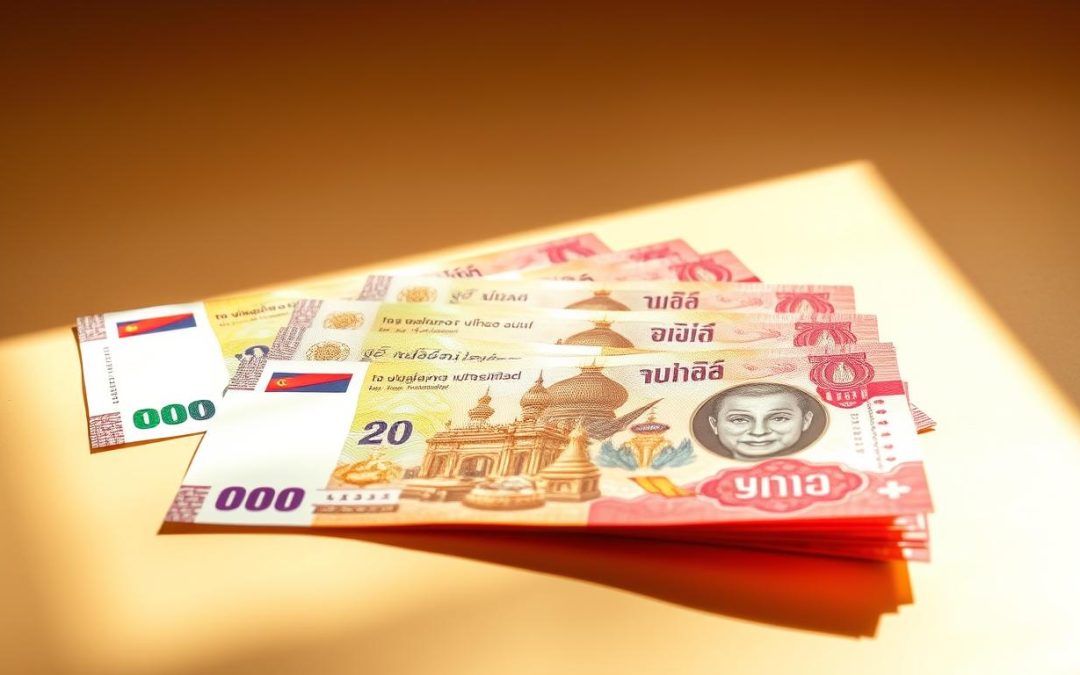Have you ever wondered how to manage your money efficiently while exploring a new country? Understanding the local currency and payment methods can make or break your travel experience. In this guide, we’ll help you navigate the financial landscape so you can focus on enjoying your trip.
Using the Thai Baht is essential during your stay. It’s the primary currency and widely accepted across the country. However, converting money abroad can sometimes be tricky. That’s why it’s crucial to know where and how to exchange your funds for the best rates.
Having a balanced mix of cash and digital payment options is key. While cash is handy for small purchases and rural areas, digital payments are becoming increasingly popular in cities. This guide will provide you with detailed insights to make informed decisions about banking, exchange, and safety during your travels.
Key Takeaways
- Using the Thai Baht is essential for most transactions.
- Exchange money at local offices for better rates.
- Carry a mix of cash and digital payment options.
- Be aware of ATM fees and withdrawal limits.
- Familiarize yourself with genuine banknotes to avoid counterfeits.
Understanding the Thai Baht Currency and Its Denominations
Navigating a new currency system can feel overwhelming, but it doesn’t have to be. The Thai Baht is the official currency, and it’s divided into 100 satang. Knowing its structure and denominations will help you manage your money effectively during your trip.
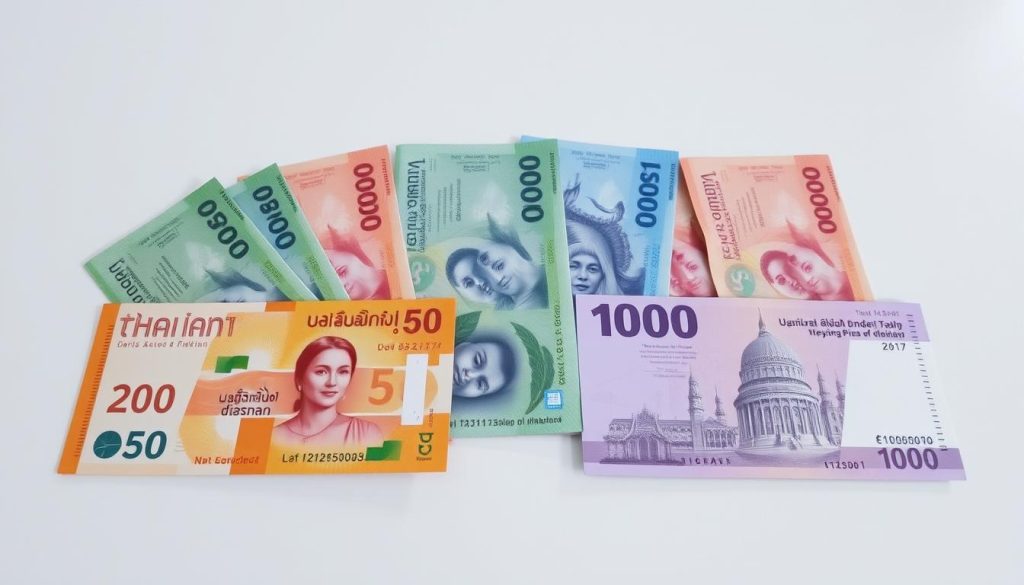
Overview of Thai Baht and Denomination Details
The Thai Baht comes in both coins and banknotes. Coins include 25 satang, 50 satang, 1 baht, 2 baht, 5 baht, and 10 baht. Banknotes are available in ฿20, ฿50, ฿100, ฿500, and ฿1000. Each denomination is widely accepted, making it easy to handle daily transactions.
For example, services like SuperRich offer competitive exchange rates, ensuring you get the most out of your money. Understanding these details is crucial for budgeting and avoiding unnecessary fees.
A Brief Historical Perspective
The Thai Baht has a rich history that dates back centuries. It evolved from a system based on silver to the modern currency we use today. Over time, the Bank of Thailand has introduced new designs and security features to prevent counterfeiting.
As of 2023, the Thai Baht ranks among the top 20 most traded currencies globally. Its value fluctuates based on market conditions, but it remains a stable and reliable currency for travelers.
| Denomination | Type | Common Uses |
|---|---|---|
| ฿20 | Banknote | Small purchases, street food |
| ฿50 | Banknote | Local transport, snacks |
| ฿100 | Banknote | Restaurants, souvenirs |
| ฿500 | Banknote | Hotels, tours |
| ฿1000 | Banknote | Major expenses, shopping |
Understanding the Thai Baht and its denominations is essential for a smooth travel experience. Whether you’re exchanging money or making purchases, this knowledge will help you navigate the local market with confidence.
Thailand: Ultimate Travelers Guide to Currencies & Payments
Managing your finances abroad can be tricky, but knowing where to exchange money makes it easier. Exchanging your funds locally often gives you better rates compared to converting them before your trip. This means more value for your money and fewer unnecessary fees.
When you arrive, look for reputable exchange offices or banks. These locations typically offer competitive rates, ensuring you get the most out of your conversion. For example, major banks like Bangkok Bank and Krungsri are reliable options with minimal fees.
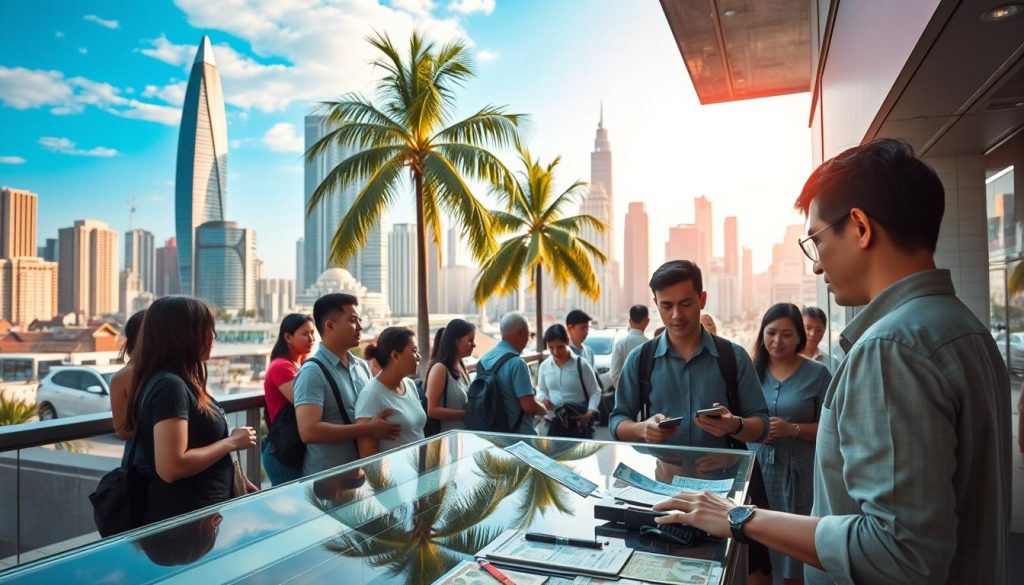
Securing the Best Exchange Rates
To get the best rates, avoid exchanging money at airports or hotels. These places often charge higher fees or offer less favorable rates. Instead, seek out trusted local offices or ATMs from major banks.
Here’s a quick comparison of common exchange options:
| Option | Exchange Rate | Fees |
|---|---|---|
| Local Exchange Office | Near-market rate | Low or none |
| Bank ATM | Competitive rate | Flat fee per transaction |
| Airport Exchange | Less favorable | High fees |
Another tip is to withdraw larger amounts at once to reduce ATM fees. This way, you’ll save on multiple transaction charges. Always check for hidden costs, such as dynamic currency conversion, and opt to pay in THB for better rates.
By following these practices, you can make the most of your money and enjoy a smoother travel experience.
Where and How to Exchange Money in Thailand
Exchanging currency wisely can save you both time and money during your travels. Knowing where to convert your cash ensures you get the best rates and avoid unnecessary fees. This section will guide you through the best options and practices for a smooth experience.
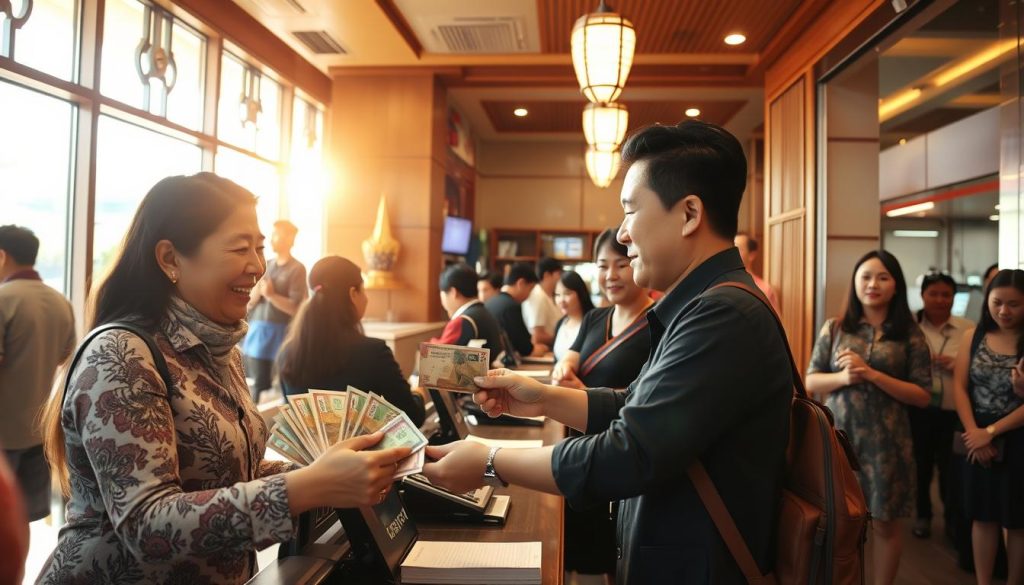
Reputable Exchange Services and Banks
When exchanging money, it’s essential to use trusted services. Local banks and accredited exchange offices often offer near-market rates. For example, major banks like Bangkok Bank and Krungsri are reliable choices with minimal fees.
Dedicated exchange services like SuperRich and Vasu Exchange are also popular. These offices provide competitive rates and are widely available in cities like Bangkok. Always check for ID requirements and compare rates before making a transaction.
Avoiding High-Fee Locations Like Airports
Airports and hotels are convenient but often charge higher fees or offer less favorable rates. Instead, plan to exchange your money in the city. Local offices and banks typically provide better value for your cash.
Here’s a quick comparison of common exchange options:
| Option | Exchange Rate | Fees |
|---|---|---|
| Local Exchange Office | Near-market rate | Low or none |
| Bank ATM | Competitive rate | Flat fee per transaction |
| Airport Exchange | Less favorable | High fees |
Another tip is to withdraw larger amounts at once to reduce ATM fees. This way, you’ll save on multiple transaction charges. Always check for hidden costs, such as dynamic currency conversion, and opt to pay in the local currency for better rates.
By following these practices, you can make the most of your money and enjoy a smoother travel experience.
Budgeting Your Cash for Different Travel Styles
Planning your budget for a trip can make all the difference in how you experience your journey. Whether you’re a budget-conscious explorer or a luxury seeker, understanding your daily expenses helps you manage your cash effectively. This guide will help you tailor your spending to your travel style.
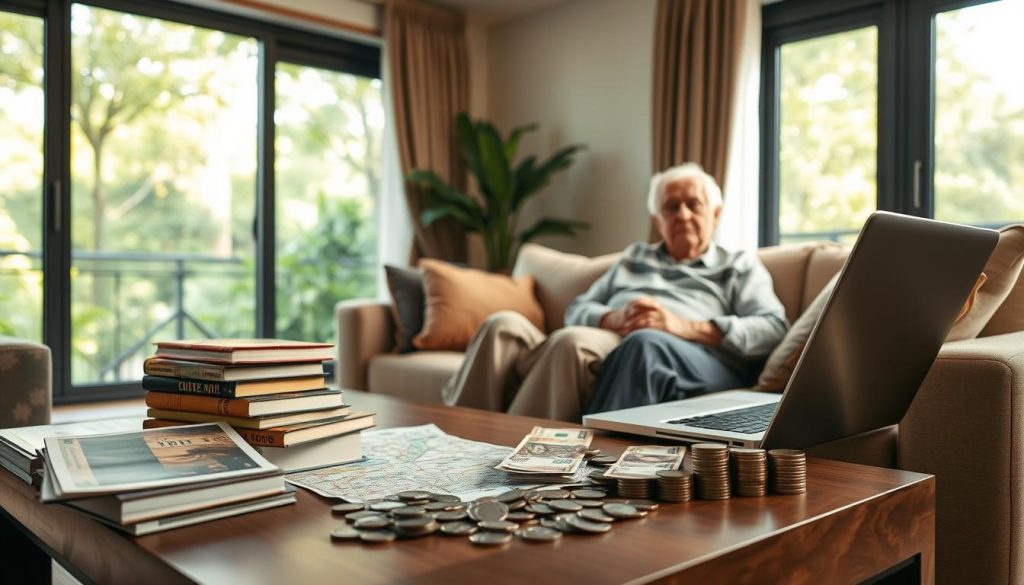
Considerations for Budget, Mid-Range, and Luxury Travelers
Your travel style directly impacts the amount of money you’ll need each day. Budget travelers can get by on $25–$45 daily, while mid-range and luxury travelers may spend significantly more. Here’s a breakdown of typical expenses:
| Travel Style | Daily Budget | Accommodation | Food | Activities |
|---|---|---|---|---|
| Budget | $25–$45 | Hostels or guesthouses | Street food | Free or low-cost tours |
| Mid-Range | $50–$100 | Comfortable hotels | Local restaurants | Guided tours |
| Luxury | $150+ | High-end resorts | Fine dining | Exclusive experiences |
For budget travelers, staying in hostels or guesthouses can save a lot of money. Street food is not only affordable but also a great way to experience local culture. Mid-range travelers might prefer comfortable hotels and dining at local restaurants. Luxury travelers can indulge in high-end resorts and exclusive activities.
Carrying a mix of cash and cards is a smart way to optimize your budget. While cash is essential for small purchases, cards are convenient for larger expenses. This approach ensures you’re prepared for any situation, whether you’re exploring a bustling city or a remote area.
By understanding your travel style and planning accordingly, you can enjoy your trip without worrying about overspending. A well-thought-out budget allows you to focus on making unforgettable memories.
Maximizing ATM Withdrawals and Card Usage
Smart ATM and card usage can save you time and money during your trip. By understanding how to optimize your withdrawals and leverage multi-currency options, you can avoid unnecessary fees and make the most of your funds.
Optimizing ATM Withdrawals to Lower Fees
Using ATMs strategically can help you minimize transaction costs. Many machines charge a flat fee per withdrawal, so withdrawing larger amounts less frequently can save you money. For example, AEON Bank ATMs charge a lower fee of 150 baht (~$4.40 USD) compared to the standard 220 baht (~$6.50 USD).
Major banks like Krungsri Bank offer higher withdrawal limits, allowing you to take out up to 30,000 baht (~$880 USD) per transaction. This reduces the need for multiple withdrawals and associated fees. Always decline the ATM’s currency conversion offer to avoid unfavorable rates.
Leveraging Multi-Currency and Prepaid Cards
Multi-currency and prepaid cards like Wise or Revolut are excellent tools for reducing conversion costs. These cards allow you to hold multiple currencies and withdraw cash in the local currency without high foreign transaction fees. For instance, the Wise card offers up to £200 in fee-free withdrawals per month.
Using these cards also helps you manage your daily amount of cash more efficiently. They are widely accepted in cities, though carrying some cash is still advisable for rural areas or smaller vendors.
By following these tips, you can make cost-effective decisions for handling your money on the go. Whether you’re withdrawing cash or using a card, these strategies ensure you stay within budget and enjoy a smoother travel experience.
Alternative Payment Methods and Digital Wallet Solutions
Exploring new ways to handle payments can make your trip smoother and more secure. Beyond cash, using credit and debit cards, along with mobile payments, offers convenience and safety for various transactions. Whether you’re dining at a restaurant or shopping in Bangkok, these methods simplify your experience.
Benefits of Using Credit, Debit, and Mobile Payments
Using a credit card or debit card provides several advantages. They make expense tracking easier and offer fraud protection, giving you peace of mind. Mobile payments, like digital wallets, are also gaining popularity. They allow you to make quick transactions without carrying physical cash.
For example, platforms like TrueMoney Wallet and Rabbit LINE Pay are widely used. These services are secure and accepted at many locations, from stores to local markets. “Digital wallets are transforming the way we pay, making transactions faster and safer,” says a recent report.
Here’s a quick look at the benefits of these payment methods:
- Convenience: No need to carry large amounts of cash.
- Security: Enhanced protection against fraud and theft.
- Efficiency: Faster transactions at restaurants, shops, and more.
When using an ATM, be mindful of fees. Withdrawing larger amounts less frequently can help you save. Additionally, consider using multi-currency cards to avoid high conversion costs. These cards are especially useful for tourists who want to manage their spending effectively.
By integrating these payment methods into your routine, you can enjoy a hassle-free travel experience. Whether you prefer a credit card or a digital wallet, these options ensure you’re prepared for any situation.
Strategies to Stay Safe When Handling Cash
Keeping your money secure while traveling is a top priority for any trip. Whether you’re exploring bustling cities or quiet streets, safeguarding your cash ensures peace of mind. Here are practical strategies to help you manage your funds safely and efficiently.
Tips for Diversifying Your Cash Holdings
One of the best ways to protect your money is by spreading it across secure locations. Carry only the amount you need for the day and store the rest in a hotel safe or bank locker. This reduces the risk of losing everything in case of theft or misplacement.
Using a money belt or hidden pouch is another smart tip. These accessories keep your cash and cards close to your body, making it harder for pickpockets to access. For added security, divide your money into different pockets or bags.
When making transactions in crowded areas or on the street, stay alert. Avoid displaying large sums of cash and keep your wallet in a secure place. If you’re exchanging money, use trusted banks or exchange offices to avoid scams.
- Store extra cash in a hotel safe or bank locker.
- Use money belts or hidden pouches for daily expenses.
- Stay vigilant in crowded areas and during street transactions.
By following these strategies, you can minimize risks and focus on enjoying your trip. A little planning goes a long way in keeping your finances secure.
Keeping Up with Currency Trends and Forecasting Exchange Rates
Staying informed about currency trends can help you make smarter financial decisions during your travels. Understanding how economic indicators and political stability influence exchange rates ensures you get the best value for your money. This section will guide you through monitoring these factors and using practical tools to stay ahead.
Monitoring Economic Indicators and Political Stability
Economic indicators like inflation, interest rates, and trade balances play a significant role in currency fluctuations. For example, Thailand’s central bank raised interest rates multiple times in 2022, impacting the Thai Baht’s strength. Political stability also affects exchange rates, as uncertainty can weaken a currency.
Tracking these indicators helps you anticipate favorable exchange rates. Tools like financial news platforms and rate alerts can keep you updated on market changes. For instance, the USD/THB exchange rate fluctuated significantly in 2022 due to global economic shifts.
Using Financial Tools to Monitor Trends
Setting up rate alerts on apps or websites allows you to act quickly when rates are favorable. Many services offer real-time updates, ensuring you never miss an opportunity. For example, platforms like Smart Currency Exchange provide live rates and expert advice to help you make informed decisions.
Forward contracts are another useful option. They let you lock in an exchange rate for up to 12 months, protecting you from unfavorable shifts. This is especially helpful if you’re planning major expenses like accommodations or tours.
| Factor | Impact on Exchange Rates | Example |
|---|---|---|
| Interest Rates | Higher rates strengthen currency | Bank of Thailand raised rates in 2022 |
| Inflation | High inflation weakens currency | Thailand’s inflation rose to 5.5% in 2022 |
| Political Stability | Uncertainty weakens currency | Global events affected USD/THB rates |
By staying informed and using the right tools, you can optimize your currency exchange and make the most of your travel budget. Whether you’re in Bangkok or exploring smaller cities, these strategies ensure you’re prepared for any financial changes.
Conclusion
Handling your finances effectively while traveling ensures a stress-free experience. By exchanging your currency at reputable places, you can avoid unnecessary costs and get the best rates. Always carry a mix of cash and cards, as smaller vendors often prefer cash, while larger establishments accept credit or debit cards.
Staying updated on currency trends helps you make informed decisions. Use tools like rate alerts to monitor fluctuations and plan your conversions wisely. This approach ensures you maximize your amount of thai baht for daily expenses like street food or transportation.
Finally, refer back to this guide as a resource for managing your money during your trip. Whether you’re at home or abroad, these tips will help you navigate financial challenges with confidence.
The above is subject to change.
Check back often to TRAVEL.COM for the latest travel tips and deals.
Here are some Tours & Sightseeing suggestions that might pique your interests!
